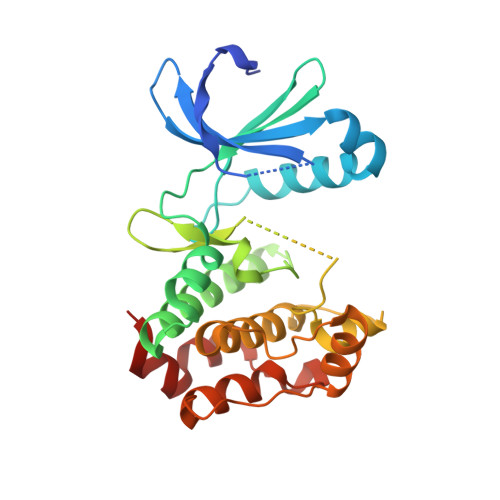Drug-Resistant Aurora a Mutants for Cellular Target Validation of the Small Molecule Kinase Inhibitors Mln8054 and Mln8237.
Sloane, D., Trikic, M., Chu, M.L., Lamers, M., Mason, C.S., Mueller, I., Savory, W., Williams, D.H., Eyers, P.A.(2010) ACS Chem Biol 5: 563
- PubMed: 20426425
- DOI: https://doi.org/10.1021/cb100053q
- Primary Citation of Related Structures:
2X81 - PubMed Abstract:
The Aurora kinases regulate multiple aspects of mitotic progression, and their overexpression in diverse tumor types makes them appealing oncology targets. An intensive research effort over the past decade has led to the discovery of chemically distinct families of small molecule Aurora kinase inhibitors, many of which have demonstrated therapeutic potential in model systems. These agents are also important tools to help dissect signaling pathways that are orchestrated by Aurora kinases, and the antiproliferative target of pan-Aurora inhibitors such as VX-680 has been validated using chemical genetic techniques. In many cases the nonspecific nature of Aurora inhibitors toward unrelated kinases is well established, potentially broadening the spectrum of cancers to which these compounds might be applied. However, unambiguously demonstrating the molecular target(s) for clinical kinase inhibitors is an important challenge, one that is absolutely critical for deciphering the molecular basis of compound specificity, resistance, and efficacy. In this paper, we have investigated amino acid requirements for Aurora A sensitivity to the benzazepine-based Aurora inhibitor MLN8054 and the close analogue MLN8237, a second-generation compound that is in phase II clinical trials. A crystallographic analysis facilitated the design and biochemical investigation of a panel of resistant Aurora A mutants, a subset of which were then selected as candidate drug-resistance targets for further evaluation. Using inducible human cell lines, we show that cells expressing near-physiological levels of a functional but partially drug-resistant Aurora A T217D mutant survive in the presence of MLN8054 or MLN8237, authenticating Aurora A as a critical antiproliferative target of these compounds.
Organizational Affiliation:
Yorkshire Cancer Research Institute for Cancer Studies, University of Sheffield, UK.















